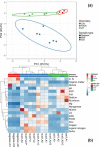Chemical and microbial characterization of sugarcane mill mud for soil applications
- PMID: 35972931
- PMCID: PMC9380943
- DOI: 10.1371/journal.pone.0272013
Chemical and microbial characterization of sugarcane mill mud for soil applications
Abstract
Sugarcane mill mud/filter cake is an activated sludge-like byproduct from the clarifier of a raw sugar production factory, where cane juice is heated to ≈90°C for 1-2 hr, after the removal of bagasse. Mill mud is enriched with organic carbon, nitrogen, and nutrient minerals; no prior report utilized 16S rRNA gene sequencing to characterize the microbial composition. Mill mud could be applied to agricultural fields as biofertilizer to replace or supplement chemical fertilizers, and as bio-stimulant to replenish microorganisms and organic carbon depleted by erosion and post-harvest field burning. However, mill mud has historically caused waste management challenges in the United States. This study reports on the chemical and microbial (16S rRNA) characteristics for mill muds of diverse origin and ages. Chemical signature (high phosphorus) distinguished mill mud from bagasse (high carbon to nitrogen (C/N) ratio) and soil (high pH) samples of diverse geographical/environmental origins. Bacterial alpha diversity of all sample types (mill mud, bagasse, and soil) was inversely correlated with C/N. Firmicutes dominated the microbial composition of fresh byproducts (mill mud and bagasse) as-produced within the operating factory. Upon aging and environmental exposure, the microbial community of the byproducts diversified to resemble that of soils, and became dominated by varying proportions of other phyla such as Acidobacteria, Chloroflexi, and Planctomyces. In summary, chemical properties allowed grouping of sample types (mill mud, bagasse, and soil-like), and microbial diversity analyses visualized aging caused by outdoor exposures including soil amendment and composting. Results suggest that a transient turnover of microbiome by amendments shifts towards more resilient population governed by the chemistry of bulk soil.
Conflict of interest statement
The authors have declared that no competing interests exist.
Figures





References
-
- Gupta N, Tripathi S, Balomajumder C. Characterization of pressmud: A sugar industry waste. Fuel. 2011;90(1):389–94. doi: 10.1016/j.fuel.2010.08.021 - DOI
-
- Chen JCP, Chou CC. Cane Sugar Handbook: A Manual for Cane Sugar Manufacturers and Their Chemists. 12th Edition ed. Hoboken NJ: Wiley; 1993.
-
- Dotaniya ML, Datta SC, Biswas DR, Dotaniya CK, Meena BL, Rajendiran S, et al. Use of sugarcane industrial by-products for improving sugarcane productivity and soil health. International Journal of Recycling of Organic Waste in Agriculture. 2016;5(3):185–94. doi: 10.1007/s40093-016-0132-8 - DOI
-
- Gilbert RA, Morris DR, Rainbolt CR, McCray JM, Perdomo RE, Eiland B, et al. Sugarcane response to mill mud, fertilizer, and soybean nutrient sources on a sandy soil. Agronomy Journal. 2008;100(3):845–54. doi: 10.2134/agronj2007.0247 - DOI
-
- Zhao D, Glaz B, Irey MS, Hu C-J. Sugarcane Genotype Variation in Leaf Photosynthesis Properties and Yield as Affected by Mill Mud Application. Agron J. 2015;107(2):506–14. doi: 10.2134/agronj14.0401 - DOI
MeSH terms
Substances
LinkOut - more resources
Full Text Sources

